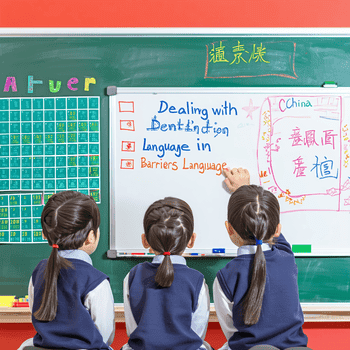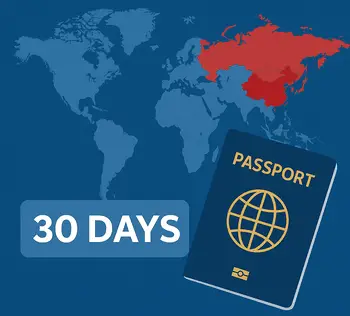
Moving to China with school-age children presents one of the biggest challenges expat families face: navigating language barriers in the education system.
With over 400,000 international students currently enrolled in Chinese schools according to the Ministry of Education, this challenge affects thousands of families annually.
Whether you’re considering local public schools, international institutions, or bilingual programs, language differences impact everything from daily communication to academic success and social integration.
This comprehensive guide provides practical strategies, real costs, and expert insights to help expat families make informed decisions and overcome language obstacles in China’s education landscape.
Understanding China’s School System and Language Challenges
The Three-Tier Challenge
China’s education system presents distinct language barriers at multiple levels:
Academic Communication
- 95% of public schools conduct all instruction exclusively in Mandarin
- Technical vocabulary and subject-specific terminology can be overwhelming
- Written assignments require character recognition and proper stroke order
Administrative Processes
- School registration documents are typically only available in Chinese
- Parent-teacher conferences conducted entirely in Mandarin
- Emergency communications and school announcements in Chinese only
Social Integration
- Playground interactions and peer relationships depend on language skills
- Extracurricular activities often assume native-level comprehension
- Cultural references and humor barriers affect friendship formation
Regional Variations
Language support varies significantly across Chinese cities:
| City Tier | English Support Level | International School Options | Local School Flexibility |
|---|---|---|---|
| Tier 1 (Beijing, Shanghai, Shenzhen) | High | 150+ schools | Moderate accommodation |
| Tier 2 (Hangzhou, Nanjing, Chengdu) | Moderate | 30-50 schools | Limited accommodation |
| Tier 3 (Smaller cities) | Low | 5-15 schools | Minimal accommodation |
Source: International Schools Database China, 2024
School Options: A Detailed Comparison
Public vs. International vs. Bilingual Schools
| School Type | Language of Instruction | Average Annual Cost (RMB) | Admission Requirements | Best For |
|---|---|---|---|---|
| Public Schools | 100% Mandarin | 0-20,000 | Residency permit, basic Mandarin | Full cultural immersion, budget-conscious families |
| International Schools | 80-100% English | 150,000-400,000 | Passport, previous transcripts | English-speaking families, temporary residents |
| Bilingual Schools | 50/50 Chinese/English | 80,000-250,000 | Varies by school | Long-term residents seeking dual language benefits |
Costs based on 2024 surveys from Shanghai, Beijing, and Guangzhou schools
Top-Rated School Options by City
Shanghai:
- Shanghai American School – Full American curriculum, grades K-12
- Dulwich College Shanghai – British curriculum, excellent Mandarin support
- Shanghai Singapore International School – Bilingual approach with Asian values
Beijing:
- International School of Beijing – IB programs with strong language support
- Beijing BISS International School – Multilingual environment
- Harrow Beijing – British education with Mandarin integration
Proven Strategies to Overcome Language Barriers
1. Pre-Arrival Language Preparation (3-6 months recommended)
Structured Learning Programs:
- Mandarin House (mandarinhouse.cn) – Offers family packages starting at RMB 8,000
- That’s Mandarin (thatsmandarin.com) – Flexible online and in-person options
- ChinesePod (chinesepod.com) – Audio-focused learning for busy parents
Essential Vocabulary Categories:
- School subjects and educational terms (200+ words)
- Health and emergency phrases (50+ phrases)
- Parent-teacher communication basics (100+ phrases)
- Administrative and enrollment vocabulary (150+ words)
2. Technology Solutions That Actually Work
| App/Platform | Primary Function | Cost | Best Feature |
|---|---|---|---|
| Pleco | Dictionary/Translation | Free-RMB 200 | Handwriting recognition |
| WeChat Translate | Real-time communication | Free | Voice message translation |
| Google Translate Camera | Document translation | Free | Live camera translation |
| Baidu Translate | China-optimized translation | Free | Better local context |
3. Building Support Networks
Essential WeChat Groups to Join:
- Shanghai Expat Network (25,000+ members)
- Beijing International School Parents
- Guangzhou Family Community
- ExpatWoman China – Comprehensive expat support
Professional Services:
- Education Consultants: RMB 5,000-15,000 for school placement services
- Translation Services: RMB 200-400 per hour for document translation
- Bilingual Tutors: RMB 300-800 per hour for academic support
Practical Solutions by Child’s Age Group
Early Years (Ages 3-6)
Focus: Language Foundation Building
- Enroll in bilingual kindergartens with 30/70 Chinese/English split
- Use picture books and educational apps
- Average preparation time: 6-12 months
Primary School (Ages 6-12)
Focus: Academic Vocabulary Development
- Intensive summer language camps (RMB 15,000-25,000 for 6 weeks)
- Subject-specific tutoring in both languages
- Average preparation time: 12-18 months
Secondary School (Ages 12-18)
Focus: Academic Excellence and University Preparation
- SAT/IB prep in English while maintaining Mandarin proficiency
- Cultural bridge programs to understand Chinese educational expectations
- Average preparation time: 18-24 months
Cost-Benefit Analysis: Investment in Language Support
Initial Setup Costs (First Year)
| Service Category | Budget Option (RMB) | Premium Option (RMB) | ROI Timeline |
|---|---|---|---|
| Pre-arrival Preparation | 10,000-20,000 | 30,000-50,000 | 6 months |
| School Consultation | 5,000-10,000 | 15,000-25,000 | 3 months |
| Ongoing Tutoring | 20,000-40,000 | 60,000-100,000 | 12 months |
| Technology/Apps | 500-1,000 | 2,000-5,000 | Immediate |
Long-term Benefits
According to a 2023 study by the Shanghai Education Commission:
- Children with pre-arrival language preparation show 40% faster integration
- Families using professional support services report 60% higher satisfaction
- Bilingual education students demonstrate superior cognitive flexibility
Expert Insights and Success Stories
Case Study: The Johnson Family (American, 2 children)
Challenge: Relocated to Shenzhen with 8 and 12-year-old children
Solution: 6-month intensive Mandarin program + bilingual school enrollment
Result: Both children achieved conversational fluency within 18 months
Total Investment: RMB 85,000 over two years
Quote: “The upfront investment seemed steep, but seeing our kids thrive in both languages made it worthwhile.” – Sarah Johnson
Professional Perspective
Dr. Li Wei, Director of Applied Linguistics at Beijing Foreign Studies University, notes: “Success in China’s education system for expat children depends heavily on early language intervention and cultural understanding. Families who invest in comprehensive preparation see dramatically better outcomes.”
Common Mistakes to Avoid
- Underestimating Timeline: Allow minimum 12 months for serious language preparation
- Choosing Schools Based Only on Cost: Factor in language support quality
- Neglecting Cultural Education: Language without cultural context limits effectiveness
- Relying Solely on Translation Apps: Human connection requires conversational ability
- Avoiding Local Integration: Mixed international/local friend groups accelerate learning
Resources and Support Organizations
Government Resources
- Ministry of Education International Department (en.moe.gov.cn)
- Shanghai Municipal Education Commission (shmec.gov.cn)
Non-Profit Organizations
- Beijing Expat Community (thebeijinger.com)
- Shanghai Expat (shanghaiexpat.com)
Professional Services
- Sinorbis Education Consulting – School placement specialists
- EIC Group (eic.org.cn) – Education and immigration services
Conclusion and Action Plan
Successfully navigating language barriers in Chinese schools requires strategic planning, adequate investment, and realistic timelines.
Start your preparation 12-18 months before arrival when possible, budget RMB 50,000-150,000 for comprehensive language support, and prioritize both academic and cultural integration.
Your next steps should include:
- Assess your family’s specific language needs using our comparison tables
- Contact 3-5 schools in your target city for detailed information
- Begin language preparation immediately, regardless of your timeline
- Connect with established expat communities for ongoing support
The investment in overcoming language barriers pays dividends not just in educational success, but in your family’s overall quality of life in China.


